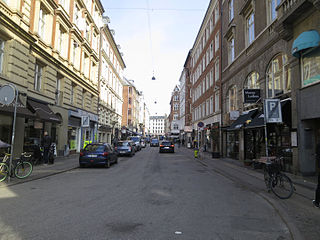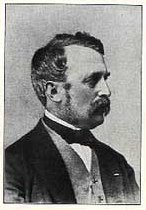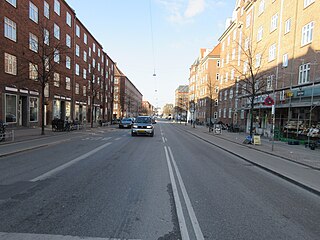
National Scala was an entertainment venue opposite Tivoli Gardens on Vesterbrogade in Copenhagen, Denmark. The building was later converted into a shopping centre and demolished in 2013.

National Scala was an entertainment venue opposite Tivoli Gardens on Vesterbrogade in Copenhagen, Denmark. The building was later converted into a shopping centre and demolished in 2013.
The building's history can be traced back to a pavilion built by Kongens Klub ("King's Club") some 200 metre further to the west in 1846. It was dismantled when the Zealand Railway Company constructed Copenhagen's new central station, in 1864, and rebuilt on the corner of Vester Farimagsvej (now Axeltorv) and Vesterbro Passage (now Vesterbrogade). In 1872, a new owner changed its name to Café Boulevard . [1]


In 1880, Hans Hansen, a well-known developer of the time, acquired the property. He commissioned Henrik Vilhelm Brinkopff to expand the complex and changed its name to Etablissementet National. At its opening on 15 January 1882, it was the first building in Copenhagen to feature electric light. It contained 73 electric lamps and had a spotlight on the top of one of the corner towers casting light onto the pavement below. The old part of the building was replaced by a new, circular concert hall, again with Brinkopff as the architect, which was inaugurated on 13 October 1893. In 1884, Hans Hansen went bankrupt and National Scala was taken over by a newly founded company. In the 1890s, the repertoire consisted mainly of theatre. The restaurant was called Euterpe. [2]
Thor Jensen, an entrepreneur who had returned from the US, then took over the building, introduced a cabarets and changed the name to La Scala in 1898. The orchestra was led by Georg Lundbye, H. C. Lundbye's son. One of the main attractions were the singer Dagmar Hansen while the American illusionist and escape artist Harry Houdini were among the guest performers. [2]

Between 1912 and 1927, with Frede Skaarup as owner and theatre director, Scala experienced a renaissance under the name Scala-teatret. The repertoire was operettas and revues, featuring popular artists such as Liva Weel and Carl Alstrup. [2]
The run-down Scala-teater closed in 1930. The building then went through a comprehensive renovation under supervision of the engineer Christen Ostenfeld, his first major assignment, and the name was changed to National-Scala. It went through another modernization in 1937 before finally closing in 1957 with debts of $150,000 and the loss of 275 jobs. [2] [3] Its last big hit was a three-week stint by Josephine Baker in 1955. [3]

The building was acquired by FDB, demolished and replaced by the Anva department store.
In the 1980s, the building was acquired by a consortium of investors, including Bent Fabricius-Bjerre. It reopened as a shopping mall after a major renovation in 1989, containing five cinemas, 12 restaurants, fitness centre as well as stores. It was never a success and changed hands several times up through the 1990s.
In 2007, a new owner, Centerplan, decided to demolish the building, launching an invited architectural competition for the site, prior to the company's bankruptcy in 2008. The participants in the competition included [[3XN|, Schmidt Hammer Lassen Architects and Plot. In 2011, Ejendomsselskabet Norden together with ATP, PFA and Industriens Pension acquired the building. New plans for the site were released in 2011 and the building was finally demolished in 2012.

The new project for the site consists of five cylinders of varying height and interconnected by skyways, positioned on a one-storey plinth. The project also proposes a renovation of the square that will enhance Fortification Ring's character of being a "green belt"surrounding the city centre. [4]

City Hall Square is a public square in the centre of Copenhagen, Denmark, located in front of the Copenhagen City Hall. Its large size, central location, and affiliation with the city hall makes it a popular venue for a variety of events, celebrations and demonstrations. It is often used as a central point for measuring distances from Copenhagen.

Kongens Nytorv is a public square in Copenhagen, Denmark, centrally located at the end of the pedestrian street Strøget. The largest square of the city, it was laid out by Christian V in 1670 in connection with a major extension of the fortified city, and has an equestrian statue of him at its centre. The initiative moved the centre of the city from the medieval area around Gammeltorv, at that time a muddy medieval marketplace, to a cobbled new square with a garden complex, inspired by the Royal city planning seen in Paris from the early 17th century.

Det Ny Teater is an established theatre in Copenhagen, Denmark, first opened in 1908. It is based in a building which spans a passage between Vesterbrogade and Gammel Kongevej in Copenhagen's theatre district on the border between Vesterbro and Frederiksberg.

Vesterbrogade is the main shopping street of the Vesterbro district of Copenhagen, Denmark. The 1.5 km long street runs from the City Hall Square in the east to Pile Allé in Frederiksberg in the west where it turns into Roskildevej. On its way, it passes Copenhagen Central Station as well as the small triangular square Vesterbros Torv. It is one of four such -bro streets, the other being Nørrebrogade, Østerbrogade and Amagerbrogade.

Østerfælled Torv is a mixed-use development surrounding a public space by the same name in the former grounds of Østerfælled Barracks in the Østerbro district of Copenhagen, Denmark. It is a result of a redevelopment of the site in the 1990s which preserved many of the old buildings, now used for retail and commercial space as well as cultural facilities, combining them with new apartment buildings.

Israels Plads is a large public square in central Copenhagen, Denmark, located in the area between Nørreport station and The Lakes. Its northern part hosts a market. Its southern part was extensively redesigned in 2014, with transition into the adjacent Ørsted Park.

Magasin is a Danish chain of department stores. It has seven department stores with its flagship store located on Kongens Nytorv in Copenhagen. The company is a subsidiary of the German department store retailer Peek & Cloppenburg Düsseldorf, Magasin du Nord has been a founder and remained a member of the International Association of Department Stores since 1928.

Tvedes Bryggeri was a brewery on Vesterbrogade in Copenhagen, Denmark. Founded by Hans Jørgen Tvede in 1852, it became the largest Nordic producer of small beer in the 1880s prior to its merger with several other breweries under the name De Forenede Bryggerier in 1891. Its buildings were converted into apartments in the 1990s. The two buildings that front the street are heritage listed.

Axeltorv is a public square in central Copenhagen, Denmark, located across the street from Tivoli Gardens' main entrance on Vesterbrogade.

Axelborg, located across the street from Tivoli Gardens on Vesterbrogade in Copenhagen, Denmark, is home to the Danish Agriculture and Food Council. DLG Group is also headquartered in the building. The building was built in 1920 and was originally constructed for a bank. An Irma flagship store opened on the ground floor in 2015 and a Vivalde Café is located on the side that faces Axeltorv..

Industriens Hus is the home of the Confederation of Danish Industries. The building is located at the corner of H. C. Andersens Boulevard and Vesterbrogade, opposite the City Hall Square, in Copenhagen, Denmark. It also contains a showroom for green technologies, House of Green, as well as a series of two-storey flagship stores and restaurants on Vesterbrogade.

Åboulevard is a street in central Copenhagen, Denmark. Together with H. C. Andersens Boulevard in the city centre and Borups Allé, it forms a major artery in and out of the city. The road is built over Ladegårds Å, a canal originally built to supply Copenhagen with water, which still runs in a pipe under it, feeding water into Peblinge Lake.

Værnedamsvej is a lively shopping street, linking Vesterbrogade and the beginning of Frederiksberg Allé with Gammel Kongevej on the border between Frederiksberg and Vesterbro in central Copenhagen, Denmark. The street was formerly known for its many specialized food stores, but is now dominated by fashion boutiques and cafés. Tullinsgade is a side street to Værnedamsvej and makes a 90 degree turn before joining Gammel Kongevej.

Rahbeks Allé is a street located on the border between Frederiksberg and Vesterbro in Copenhagen, Denmark. It runs from Vesterbrogade in the northeast to the corner of Søndermarken in the southwest where it joins Pile Alle just before it turns into Valby Langgade on the border to Valby.The former Carlsberg brewery site which is under transformation into a new, dense neighbourhood is located on the south side of the street. Its north side is lined with low, mostly three-storey late-19th century apartment buildings with small front gardens.

The Karel van Mander House /Danish: Karel van Manders Gård) is a historic building located at the central shopping street Strøget (Østergade) in Copenhagen, Denmark. It takes its name after the artist Karel van Mander III (1609-1670) who was a resident for a few years. It later played host to the gentlemen's club Kongens Klub from 1776 to circa 1850.A Hugo Boss flagship store now occupies the ground floor.

Kongens Klub was a gentlemen's club founded in 1776 in Copenhagen, Denmark. The club was until the late 1840s based in the Karel van Mander House at Østergade 15. It existed until 1877 when it was merged with Det forenede borgerlige Selskab under the name Kjøbenhavns Klub.

Harald Conrad Stilling was a Danish architect who was active in Copenhagen during the Late Classical period of the mid-18th century. He received the C. F. Hansen Medal in 1841.

Westend is a street and Art Deco-style housing complex in the Vesterbro district of Copenhagen, Denmark. It links Vesterbrogade in the north with Mathæusgade and Otto Krabbes Plads in the south. It is accessed through a gateway in the building at Vesterbrogade 65–78 and is closed to car traffic in the other end.
Vilhelm Heinrich Friederichsen was a Danish architect.

Enghavevej is a major street in the Vesterbro and Kongens Enghave districts of Copenhagen, Denmark. It runs from Vesterbrogade in the north to Sydhavns Plads in the south, linking Kingosgade with Sydhavnsgade and Borgbjergsvej.